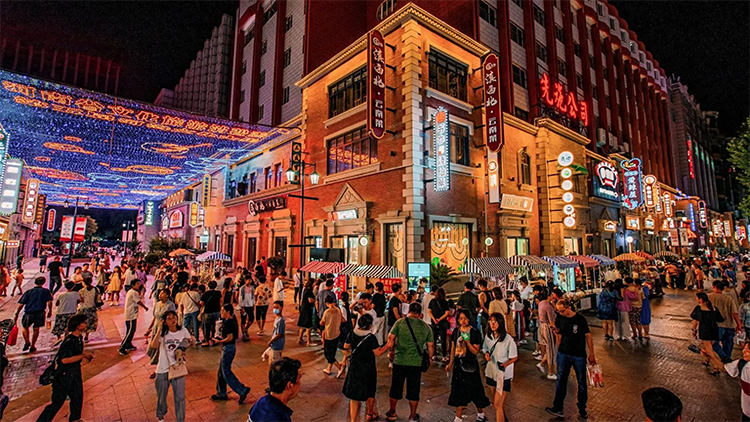Local Market Tips: Your Luoyang & Guangzhou Market Walk Guide
Introduction
When the late sun gilds the red-brick facades and the air fills with the rich aroma of long-simmered broths, the clatter of bicycles and the cadence of local bargaining dialects weave together — this is everyday life on Luoyang’s Guangzhou Market Walk. Founded in the 1950s, this commercial corridor has simmered for more than half a century to form a distinct “Luoyang flavor”: state-run storefront signs on the left, neon milk-tea shops on the right, and blue stone slabs underfoot stamped with peony patterns — a living market that feels like a cross-century street exhibit.
1. Soul Positioning: A Mix of State-Run Memory and Street Life
“Using 1950s red brick to hold up 21st-century night lights” — locals say this to capture the market’s magical-realism character. The square, practical layout of the planned-economy era remains, while renovations have injected the openness and energy of modern pedestrian streets. Unlike the quiet polish of high-end malls, here you’ll see a grandfather strolling in pajamas and young tourists with selfie sticks queuing at the same soup shop.
2. Shopping Guide: The Joy of Treasure Hunting
– Old-brand gems:
Local department store Dashin (Da Xin Department Store) still displays goods in glass counters from another era; their peony-scented soaps and Tang Sancai-style figurines make great souvenirs. Around the corner, the Friendship Store sells vintage enamel mugs stamped with “Luoyang” that foreign visitors love.
– Budget paradise:
Cotton T-shirts for 30 RMB, two pairs of handmade cloth shoes for 50 RMB — clothing prices feel frozen in time. Electronics stalls often sell Huawei and Xiaomi display units about 20% cheaper than official stores.
– Hidden plays:
The Sunday Worker Cultural Market is a must for local artisans: look for Master Li’s shadow-puppet props and Auntie Cui’s naturally dyed scarves.
3. Taste Trail: From State Canteens to Viral Night Stalls
– Three must-try dishes:
– “Lao Guangzhou Bu-fan Tang” (老广州不翻汤): a slow-simmered broth of native chicken and herbs, served with crispy bread; Stall 17’s version is the most authentic.
– “Jianxi Beef Tripe Hotpot” (涧西涮牛肚): in the repurposed state canteen “Hongguang Eatery,” the secret sesame dipping sauce is unforgettable.
– “Peony Snowflake Yogurt” (牡丹雪花酪): a photogenic ice dessert from the stall “Luocheng Memories,” shaped like petals and perfect for photos.
– Rest recommendation:
The renovated Workers’ Cultural Teahouse offers unlimited refills of high-mountain Maojian tea for 3 RMB; the second-floor terrace provides a great street view.

4. Spatial Storytelling: Find Historical Easter Eggs in the Architecture
The mid-street “Industrial Memory Gallery” displays rusted gear installations and embeds a 1956 factory map into the pavement. The west entrance’s “Time Post Office” lets you mail postcards stamped with a Luoyang Tractor Factory commemorative postmark. After 7 PM, don’t miss the naked-eye 3D projection show “Peonies Blooming” projected onto the red-brick wall.
5. Practical Tips: Shop and Eat Like a Local
– Best time:
Arrive around 5 PM to browse stores (many close by 8 PM) and then explore the night market (open until midnight). Open-air Yu Opera performances often run Wednesdays and Fridays.
– Payment tips:
About 90% of shops accept WeChat Pay, but cash is handier at night stalls. The nearest ATM cluster is at the east entrance ICBC branch.
– Hidden perks:
Show your foreign passport at the Tourist Center (near Metro Exit A) to get a bilingual “treasure map” with coupons for 10 old-brand shops.
Transport combos:
– Metro Line 1: Guangzhou Market Station, Exit D leads straight to the pedestrian archway
– Shared-bike docks: west side of Peony Square at the street’s end
– Driving: Park at Zhongzhou International Parking (first hour free)

Conclusion
At Guangzhou Market Walk, shopping is only the medium — what’s really sold here is a Luoyang way of life that isn’t hurried. When you hear someone humming the “Peony Song” at an old tea stall in the local dialect, you’ll understand: the street’s most precious product is the human warmth that time hasn’t taken away.


